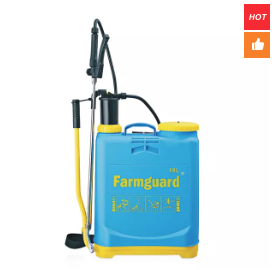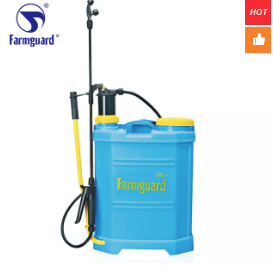Fax:0086-576-88129398
close
Choose Your Site
Global
Social Media
Views: 0 Author: Site Editor Publish Time: 2025-10-14 Origin: Site









Looking for an efficient way to apply liquids in your garden or project? A manual sprayer could be the solution. This tool is perfect for spraying water, fertilizers, pesticides, and more.
In this article, we will show you how to use, maintain, and operate a hand-held sprayer. You’ll learn how to make the most of your manual sprayer for any task, whether it’s for gardening, cleaning, or pest control. A hand-held sprayer is a portable, manually-operated tool designed to spray liquids such as water, fertilizers, herbicides, pesticides, or cleaning agents. It typically consists of a spray tank, pump mechanism, nozzle, and trigger. The user pumps the handle to build pressure in the tank, which forces the liquid through the nozzle, allowing for controlled, efficient application.
Hand-held sprayers are widely used in various fields such as gardening, agriculture, cleaning, and pest control. Their compact size and ease of use make them suitable for both indoor and outdoor tasks, allowing precise application in hard-to-reach areas or smaller projects.
In the following sections, we’ll guide you through the process of using a hand-held sprayer, how to maintain it, troubleshoot common issues, and ensure its longevity.
Before diving into how to use a hand-held sprayer, it’s helpful to understand the mechanics of how it functions. The basic principle behind a hand-held sprayer is simple: manual effort is converted into pressure, which forces the liquid solution through the nozzle to create a spray.
A typical hand-held sprayer is composed of the following parts:
1. Spray Tank (Reservoir): This is where the liquid solution is stored. Hand-held sprayers usually range from 1 to 5 liters in capacity. A larger tank allows for longer use but adds weight.
2. Pump Mechanism: This component creates pressure within the tank when manually operated. The pump handle is repeatedly pressed to build pressure that is necessary for spraying.
3. Nozzle: The nozzle controls the spray pattern and pressure. You can adjust it to provide a fine mist, a fan-shaped spray, or a concentrated stream, depending on your needs.
4. Trigger: The trigger is used to release the spray, making it easy to control the flow of liquid as you work.
5. Pressure Relief Valve: This is an important safety feature. It allows you to release excess pressure before opening the tank, preventing accidental spillage or injury.
6. Handle and Carry Strap: These parts allow for easier handling and carrying of the sprayer, especially when filled with liquid.
The sprayer relies on the manual pumping of the handle to build pressure inside the tank. As the pressure increases, it forces the liquid solution out of the nozzle, where you can control its flow by squeezing the trigger.

Before you begin using the sprayer, ensure that all parts are in good working condition. Here are some checks you should perform:
· Spray Tank: Check for any cracks or leaks that may cause the solution to leak out.
· Pump Mechanism: Ensure that the pump operates smoothly. If there’s any resistance or difficulty while pumping, the mechanism might be clogged or damaged.
· Nozzle: Make sure the nozzle is clean and properly adjusted. A clogged nozzle can result in uneven spraying.
· Hose and Trigger: Check that the hose is securely attached and not cracked. The trigger should move freely without obstruction.
Tip: Always inspect the pump mechanism to ensure it’s not clogged or damaged, especially if you’ve used it for chemicals in the past. Regular maintenance ensures that the sprayer functions correctly for every use.
The next step is to prepare the solution you plan to spray. This could be:
· Water for basic watering tasks.
· Fertilizers to help your plants grow.
· Pesticides or Herbicides to eliminate unwanted pests or weeds.
· Cleaning agents for surfaces, vehicles, or equipment.
Make sure you follow the manufacturer’s instructions on mixing ratios to avoid applying too strong or too weak a solution.
Important: If you are using pesticides or herbicides, always handle them with care. Wear gloves, goggles, and a mask to avoid exposure to harmful chemicals.
Tip: For better application results, always mix the solution in a separate container before adding it to the sprayer. This ensures the ingredients are properly combined and reduces the risk of clogging.
Before opening the sprayer, always release any built-up pressure by pressing the pressure relief valve. This prevents the sudden release of liquid when you open the tank and helps avoid spills or accidents.
Tip: Be cautious when using pesticides or herbicides as these chemicals can be harmful to your skin and eyes. Always make sure to release pressure before unscrewing the cap. This is a vital safety measure to avoid chemical exposure.
Now that you’ve released the pressure, unscrew the tank cap and pour your prepared solution into the sprayer. Use a funnel to avoid spillage, especially if you're using a chemical solution.
Tip: Do not overfill the tank. Leave a small gap to allow for pressure to build properly. Overfilling may lead to leaks or decreased spraying efficiency.
After filling the tank with the solution, replace and securely tighten the cap. Ensure it’s sealed correctly to prevent leaks during use. A tight cap ensures that the sprayer maintains the internal pressure, which is necessary for proper spraying.
Once the solution is added and the cap is secure, begin building pressure inside the tank. This is done by pumping the handle up and down. Most hand-held sprayers require around 20-30 pumps to build sufficient pressure. The more pressure, the stronger the spray.
Tip: Always check the sprayer’s maximum pressure rating and avoid exceeding it to prevent damage to the sprayer. Over-pressurizing the sprayer could cause leaks or failure of the system.
Hand-held sprayers often come with adjustable nozzles. You can rotate or adjust the nozzle to set the desired spray pattern. Some common spray settings include:
· Fine Mist: Ideal for delicate plants or spraying chemicals that require a light, even application.
· Fan Spray: Best for covering a larger area with a broad spray.
· Jet Stream: Perfect for reaching further distances or targeting specific areas, such as weeds or pests.
Adjusting the nozzle allows for precise application depending on the task. Choosing the right spray pattern can save you time, reduce waste, and improve efficiency.
Once the sprayer is pressurized and the nozzle is adjusted, you can begin spraying. Squeeze the trigger to release the solution, directing it at the target area.
Tip: Keep the sprayer upright and ensure the nozzle is aimed at the intended surface. Avoid tilting the sprayer at extreme angles, as it could affect the spray pattern and even cause leakage.
Tip: When spraying for extended periods, it’s helpful to use the locking feature (if available) on the trigger to allow for continuous spraying. This helps reduce hand fatigue during large-scale tasks, especially if you're spraying a large area.
As you use the sprayer, the internal pressure will drop, reducing the spray’s force. To maintain a steady spray, you will need to pump the handle periodically. This will keep the liquid flowing at a consistent rate, ensuring an even application throughout the task.
If the sprayer isn’t dispensing liquid, it could be caused by one of the following issues:
· Clogged Nozzle: Clean the nozzle with warm water or a needle to remove blockages. Ensure that it is free from debris that may block the flow of liquid.
· Insufficient Pressure: If the sprayer isn’t pressurized enough, continue pumping the handle until adequate pressure is built. This is a simple solution to restore functionality.
· Air Leaks: Check the hose and tank for leaks, as they can cause a loss of pressure. Ensure all connections are tight and secure.
Leaks are usually caused by:
· Damaged Seals: Over time, seals can wear out. Inspect and replace them if needed. It’s essential to use the right sealant to avoid fluid leakage.
· Loose Cap: Ensure the tank cap is tightly secured to avoid spillage and maintain pressure. A loose cap can reduce efficiency and cause messes.
· Cracks in the Tank: If the tank is cracked, it will need to be replaced. The integrity of the tank is crucial to maintaining proper pressure and preventing leaks.
An uneven spray could be the result of:
· Clogged or Misaligned Nozzle: Clean the nozzle thoroughly and ensure it’s adjusted correctly. Misaligned nozzles can cause inconsistent spray patterns.
· Incorrect Pressure: Check the pressure level and make sure it’s within the recommended range for optimal spray. If the pressure is too low, the spray may be weak and uneven.
Using a hand-held sprayer correctly is essential for maximizing its effectiveness and lifespan. Whether you're using a manual sprayer for watering, applying pesticides, or cleaning, following the right procedures ensures you get consistent, controlled results.
By properly preparing the solution, building pressure, maintaining the sprayer, and addressing any issues promptly, your hand-held sprayer will continue to perform at its best. Regular maintenance and proper storage will help extend the life of your sprayer, making it a valuable tool for years to come.
Taizhou Guangfeng Plastic Co., Ltd offers durable, high-quality sprayers that are perfect for a wide range of applications. Their products are built to last and offer reliable performance, making them an excellent choice for anyone looking to get the most out of their sprayer.
A: Yes, hand-held sprayers are perfect for applying pesticides. Ensure you follow the manufacturer's mixing instructions and wear protective gear. Always read the safety guidelines before using chemical solutions.
A: Use a needle or small brush to clear the blockage. If needed, soak the nozzle in warm water to loosen any debris. Regular cleaning will maintain the sprayer's performance.
A: Most sprayers have an adjustable nozzle. Simply rotate the nozzle to change the spray pattern from a fine mist to a concentrated stream. Test the spray before applying to ensure the desired effect.
A: You should clean your sprayer after each use and check for leaks or damage. Regular maintenance ensures the sprayer operates at peak performance. Inspect seals, nozzles, and the tank for any wear and replace as necessary.
Taizhou Guangfeng Plastic Co.,Ltd is specialized in manufacturing agriculture knapsack sprayers and garden sprayers for more than 28 years.Products exported to over 50 countries and our brand Farmguard shares great fame in the world. If you want to know more, welcome to contact us.
